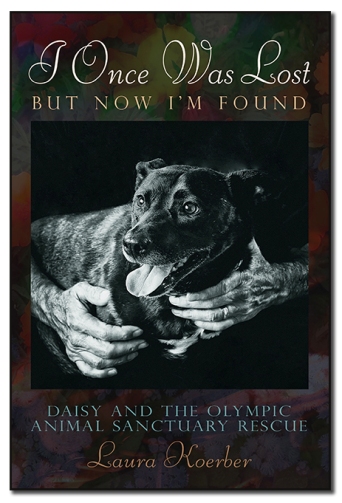
My dog Khronos (left) and Sam (right) one of our two houseguests playing in front of open crates.
 I left active rescue in 2015, so it’s been awhile since I thought much about the use of crates for dogs, in rescue or otherwise.
I left active rescue in 2015, so it’s been awhile since I thought much about the use of crates for dogs, in rescue or otherwise.
But between the release of our latest book from Who Chains You Publishing— I Once Was Lost, But Now I’m Found: Daisy and the Olympic Animal Sanctuary Rescue—and my occasion to use crates this week for two dogs I’m babysitting, I was forced once again to look the issue in the eye and give it a good mulling over.
My dog Khronos has been with us for over a year now, so he’s trained to a doggie door and is a perfect gentleman inside the house, no longer needing or using a crate.
Yet we still have one or two of them, folded up and gathering dust in the back basement room, most likely to get used soon when I foster a dog. It’s always good to have a crate around, even when your pack is stable and you have no foster doggies…just in case.
But just how much crating IS acceptable? When does crating a dog become cruelty?
I’ve always been a big believer in the ultimate freedom for our companions…which to my mind meant chain-free AND cage-free was the ONLY way to go.
So when I came into rescue I’d never used a crate before, viewing them as borderline cruel. However, eventually—and through multiple foster dog situations—I was forced to change my mind and opinion when matters of safety and sanity reared their ugly heads.

George, my other little houseguest. Yes, that underbite is just too cute…at least all the rescue ladies think so, cooing when I post his pic on my page.
Sam and George’s dad doesn’t crate them at home anymore, either. He’s had the boys with him for years, and both are well-trained to his house and know their daily schedule.
But I asked him to bring his crates with the dogs for the 12 days they’d be staying here. Because the truth is, when you combine new dogs with your own family dog(s) and/or cats or other companions, one never knows what can happen, and it’s much better to be safe than sorry. A crate is a useful tool that can and will keep everyone secure at bedtime or if you have to leave the home for work or errands.
The boys have now gotten used to my dog, and the three have started playing quite nicely together, but I still wouldn’t leave them alone without crating our visitors. Why? Because I’m not going to take the chance that I get up in the morning or come home from town to discover that play turned violent and someone’s been injured, or something was destroyed and eaten that could harm one of them. If I’m not here to directly supervise, the crates will be used.

Khronos and Sam posing for their pic like good boys.
So I crated Sam and George for bed both nights so far (and probably will every night they’re here so I don’t lay awake worrying). Then today I wanted to go to town for a few hours, and I’m not gonna lie—this put me in a dilemma.
I felt hella guilty about crating them again after they’d spent eight hours in the crate overnight.
But I knew I had to. For my peace of mind and their safety.
So to assuage my guilt, I took all three dogs for a half mile walk on our property. Then I fed them. Then I took them for another half mile walk. Only then did I feel they’d had enough exercise to sleep in their crates while I was gone.
And when I came home a few hours later? I immediately took them for another half mile walk, fed them, and walked them again.
And guess what? I STILL felt guilty about leaving them in the crate for the time I was gone!
Which got me to thinkin’…
If I feel distressed about leaving two dogs in their crates at night and while I run out to do errands—when I know it’s for their safety AND only after making sure they get some good exercise—WHAT KIND OF MONSTER IS PSYCHOLOGICALLY CAPABLE OF LEAVING A DOG IN A CRATE FOR DAYS, EVEN YEARS, ON END?

One of the crates outside the Olympic Animal Sanctuary. Note the hardened and crystalized urine encrusted on the top. Can you imagine the suffering?
Seriously, don’t you wonder that, too? Who can emotionally handle that kind of guilt?
Unless…unless you just don’t feel guilt.
Unless you don’t feel empathy for other beings, feel responsible for their welfare, feel any of the emotions that a normal human being should feel.
Because leaving a dog crated for years on end, forcing him to sleep in his own defecation and urination, refusing to walk the dog, allow him to stretch his legs, or provide daily food and water? That’s just the definition of heartless. And that’s exactly what Steve Markwell, founder of the Olympic Animal Sanctuary in Forks, Washington, did to the dogs in his care. He went out into the world, misrepresented himself as the ultimate dog trainer, got rescues to send him their difficult dogs under the guise of rehabbing them, and then plopped them in crates as if they were nothing more than props, wandering back out to repeat the pattern.
And I just don’t understand HOW. HOW could anyone do that?
If you’re a dog rescue or foster home who’s working out of crates, think long and hard about the appropriate amount of time a dog can be crated without slipping into the realm of cruelty and neglect.
Dogs need daily walks, AND they need time to just BE DOGS. To wrestle around with other dogs or their humans. To play, to lounge, to loll, to eat, to drink. If you’re crating dogs longer than bedtime and while you’re at work or out running errands, it’s too long.
If dogs can’t have hours a day to be a (supervised when needed) part of the family, IT’S NOT ENOUGH.
I still believe dogs deserve as much freedom as humanly possible. I’ve grown to understand that this often includes the use of appropriate crating, living INSIDE the home with the family, playtime, and a walk daily or as often as possible.
No matter if you’re a home-based dog rescue or a family fostering or training a new dog, keep in mind that crates are tools, nothing more. The ultimate goal of crating is to achieve the point where your dog no longer needs the crate—but for those dogs who see their crate as a den, it can remain available in the home with the door open so they are free to go in and out as desired.
 In the case of the OAS dogs, many of them eventually earned their freedom from crating hell, thanks to those in the rescue community who did their parts and kept up the pressure on Markwell until the goal was achieved.
In the case of the OAS dogs, many of them eventually earned their freedom from crating hell, thanks to those in the rescue community who did their parts and kept up the pressure on Markwell until the goal was achieved.
As Laura Koerber, the author of I Once Was Lost, But Now I’m Found: Daisy and the Olympic Animal Sanctuary Rescue states, “the OAS rescue was an epic narrative that extended over several years and featured small town politics, protests, assault, lawsuits, arrests, and a midnight escape, all played out to a nationwide audience.”
If you haven’t read it yet, I highly recommend the book; the story is nothing short of astounding. I think you, too, will be left with the same burning question I am: HOW?
HOW could anyone do that?
I just don’t know the answer.
Interested in the book? Here’s the links to read more or buy:
Buy on Amazon | Buy on Kindle | Buy from Createspace and $1 Will be Donated to our Charity of the Year







 In the case of the OAS dogs, many of them eventually earned their freedom from crating hell, thanks to those in the rescue community who did their parts and kept up the pressure on Markwell until the goal was achieved.
In the case of the OAS dogs, many of them eventually earned their freedom from crating hell, thanks to those in the rescue community who did their parts and kept up the pressure on Markwell until the goal was achieved.
You must be logged in to post a comment.